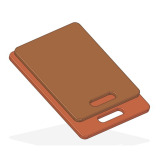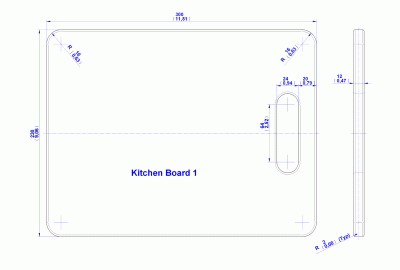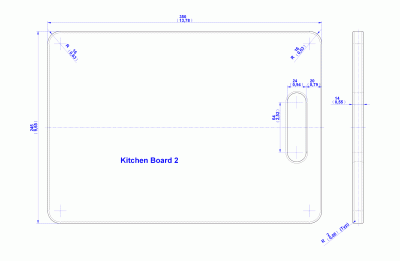We offer the plan for a very simple kitchen chopping board in two sizes. This plan is just an idea, and you can adjust the dimensions to your needs.
Kitchen chopping board is one of the most used kitchen utensils. It serves us to keep the kitchen work surface clean, dry, spotless and odorless, and also to protect the surface from the cut marks that are inevitable during the grocery chopping. It is recommended to have at least two or even more chopping boards. One should be used only for chopping raw meat and fish, another for fruits and vegetables – and you should always pay attention to cut fruits on one side and use the other side for vegetables, especially for onions, garlic and other types of vegetables that release juices with strong smell. It will be good to use separate kitchen board to cut groceries that do not need further thermal preparation like roasted meat, delicatessen, cheeses and similar.

Chopping board - Version 1: 230mm (9.06'') x 300mm (11.81'') x 12mm (0.47'')
Chopping board - Version 2: 245mm (9.65'') x 350mm (13.78'') x 14mm (0.55'')
The good kitchen chopping board should be soft enough, so it would not dull knives during the chopping, yet firm enough so the knife will not damage it. Surface of the chopping board should not be abrasive, so it will not contaminate food with particles of material out of which the board is made. It should not be porous, so it will not absorb juices from food, because they could contaminate food which will later be cut on this board. Since the kitchen chopping board comes into direct contact with food, it should be made out of material that can be easily and efficiently cleaned to prevent growth of germs on the remaining food particles.


The most common materials for manufacturing the chopping boards are wood and plastic. The advantage of plastic is that it can be washed in the dishwasher and it is cheap. Disadvantages of the plastic boards are that chopping with knife causes cut marks that are difficult to clean and they can retain small particles of food, on which the bacteria grow. On the other hand, the wooden boards are made out of natural material, so there is no problem if the small particles of wood will ends up in food. In addition, the wood fibers tend to return in its original position, so the wooden kitchen boards – even after the longer usage – do not have significant cut marks, because wood has self-healing property. Regardless the fact that wood can not be washed in the dishwasher, it was proven that by regular washing and cleaning of the food remains, there is not germ harboring on the wooden boards, and the germs disappear only several hours after washing. Therefore, from the health aspect it is much safer to use the wooden chopping boards. Another advantage of the wooden boards is that they do not damage the knives blades as much as the other materials do.
We offer the plan for a very simple kitchen chopping board in two sizes. This plan is just an idea, and you can adjust the dimensions to your needs. When choosing the wood type for the kitchen chopping board, you should make sure that wood do not have toxic or allergenic reputation (that have the most of tropical types), does not contain resins that could spoil the taste of your food (such as most of the softwoods), do not release color or tannins. It should be tightly grained, hard and durable, and it should not have large or open pores like for example the red and white oak.
Some of the hardwood species that meet the strict criteria for making a good kitchen utensil are Olive wood, hard maple and Osage orange. A good choice is also cherry, birch, beech, apple, hornbeam or American sycamore wood. All of the listed wood types are hard, dense, tightly grained with closed or very small pores, and besides that are very decorative.
It is very important to do proper surface treatment of your chopping board. It should be sanded several times until the surface become perfectly smooth. We recommend you to leave the wood natural – without coating, but if you wish, use some penetrating, water resistant and food safe finish. For this purpose you can use beeswax, walnut oil or food-safe mineral oil. Do not use vegetable oils like olive oil, because these types of oil go rancid very fast.
Maintain your kitchen chopping boards by hand washing with soap and sponge under running tap water after each use. Never leave it soaked in water and do not wash it in the dishwasher. Wipe it and dry thoroughly after washing and store it in a dry place.